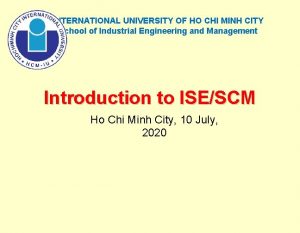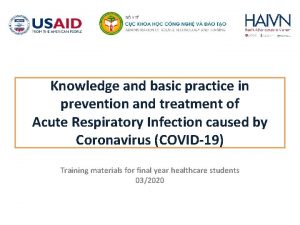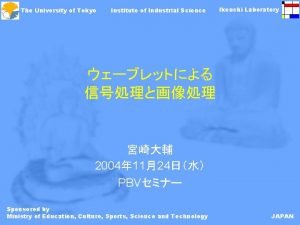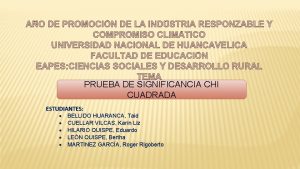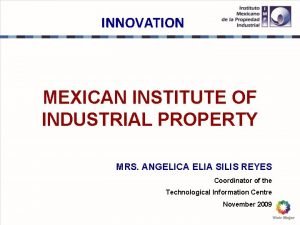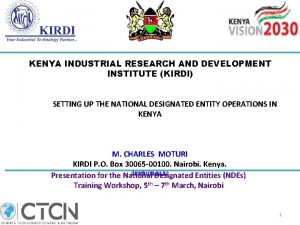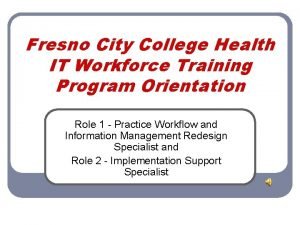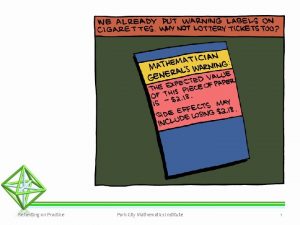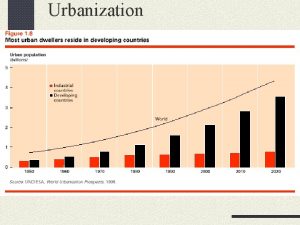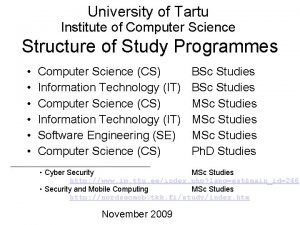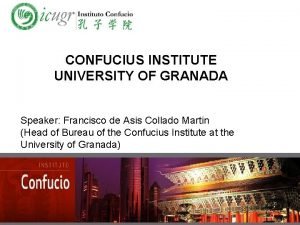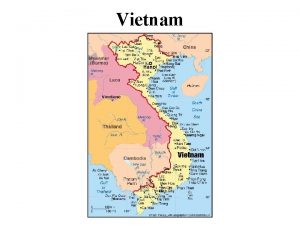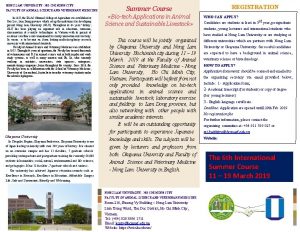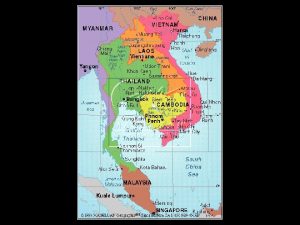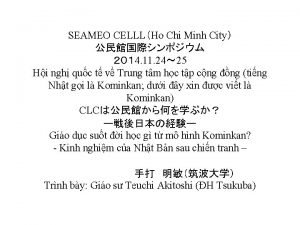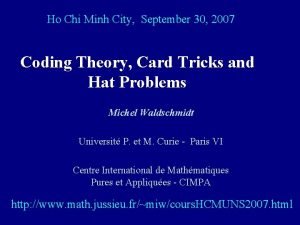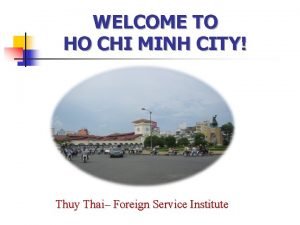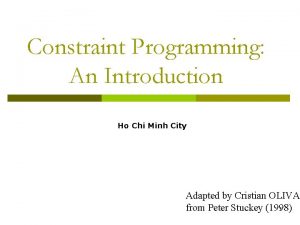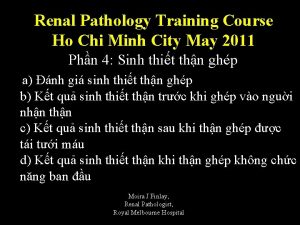Industrial University of Ho Chi Minh City Institute







































- Slides: 39

Industrial University of Ho Chi Minh City Institute of Biotechnology and Food technology Introduction to Biotechnology TRẦN GIA BỬU

Outlines Chapter 1: The Biotechnology Century and Its workforce Chapter 2: An Introduction to genes and Genomes Chapter 3: Recombinant DNA Technology and Genomics Chapter 5: Microbial Biotechnology Chapter 6: Plant Biotechnology Chapter 7: Animal Biotechnology Chapter 8: DNA fingerprinting and Forensic Analysis Chapter 9: Bioremediation Chapter 10: Aquatic Biotechnology Chapter 11: Medical Biotechnology Chapter 12: Biotechnology Regulation Chapter 13: Ethics and Biotechnology

Chapter 2 An introduction to gene and Genome Tran Gia Buu

Contents I. DNA-the inherited genetic material II. DNA and chromosome structure III. Gene expression control IV. Epigenome- epigenic modification

1. DNA-the inherited genetic material • The substance we now call DNA was first described in 1869 by Johannes Miescher (nuclein) • In 1928, Frederick Griffith provided evidence that DNA is inherited genetic material – Heat destroyed the ability of lethal S bacteria to cause pneumonia, but it did not destroy their hereditary material – The hereditary material could be transferred from dead S cells to live R cells

Frederick Griffith experiment

1. DNA-the inherited genetic material • In 1944, Oswald Avery, Collin Mac. Leod and Maclyn Mc. Carty identified that the “transforming principle” was a nucleic acid – Lipid- and protein-destroying enzymes did not block the S cell’s transformation of R cells – DNA-degrading enzymes, but not RNA-degrading enzymes, prevented transformation – They concluded that DNA must be the genetic material causing transformation

Avery, Mac. Leod and Mc. Carty experiment

1. DNA-the inherited genetic material In the late 1940 s, Alfred Hershey and Martha Chase established that DNA transmits a full complement of hereditary information – They established that the material bacteriophage (a virus that infects bacteria) injects into bacteria is DNA, not protein

Alfred Hershey and Martha Chase experiment

2. DNA and chromosome structure • Building blocks of DNA – DNA is a polymer of nucleotides, each with a fivecarbon sugar, three phosphate groups, and one of four nitrogen-containing bases : A and G (purines), C and T (Pyrimidines)

2. DNA and chromosome structure 1953: James Watson and Francis Crick suspect that DNA is a helix • Structure of DNA helix: – Two sugar–phosphate chains running in opposite directions, and paired bases inside (antiparallel) – Phosphodiester bonds between the sugar of one nucleotide and the phosphate of the next form the backbone of each chain (or strand). – Hydrogen bonds between the complementary base pairs (A to T, G to C) in opposite strand hold the two strands together


2. DNA and chromosome structure What is gene? Gene usually is described as units of inheritance. A gene is a sequence of nucleotides that provides cells with the instructions to synthesize a specific protein or a particular RNA, approximately 1, 000 -4, 000 nucleotides long. Note: Not all genes are used to produce a protein.

2. DNA and chromosome structure Chromosome structure • DNA in a single human cell is about 2 meters (6. 5 feet) long • How can that much DNA pack into a nucleus that is less than 10 micrometers in diameter? – Proteins associate with the DNA and help keep it organized

2. DNA and chromosome structure Chromosome structure • Chromosome: structure that consists of DNA and associated proteins – Carries part or all of a cell’s genetic information • Histone: type of protein that structurally organizes eukaryotic chromosomes • Nucleosome: a length of DNA (146 base pairs) wound twice around a spool of histone proteins (8 histone molecular: 2 H 2 A, 2 H 2 B, 2 H 4, 2 H 3)


2. DNA and chromosome structure What is genome? All of the DNA in an organism ‘s cell is called the genome. Human genome approximately 20, 000 genes scattered among 3 billion base pairs. The study of genomes called genomics, the area within genetics that concerns the sequencing and analysis of an organism's genome.


3. Gene expression regulation The flow of genetic information Prokaryote: DNA → m. RNA → protein Eukaryote: DNA → Pre m. RNA → protein

The flow of genetic information in eukaryote

3. Gene expression regulation Both of these cells contain the same genome, but they express different RNAs and proteins. – Some genes affect structural features and metabolic pathways and are expressed in many cell types – Others genes are expressed only by certain subsets of cells (e. g. , globin in RBCs) – Control over gene expression allows cells to respond to changes in their environment

3. Gene expression regulation The level of gene expression regulation 1. transcription, 2. RNA splicing 3. translation, and 4. post-translational modification of a protein

2. Gene expression control Different ways of gene expression regulation in bacteria 1 - Promoter recognition. 2 -Transcription elongation (Attenuation). Regulation of gene expression can be done by some operon pathways such as lac operon, tryptophan operon.

OPERON in gene regulation of prokaryotes: Definition: a few genes that are controlled collectively by one promoter Its structure: Each Operon is consisted of few structural genes( cistrons) and some cis-acting element such as promoter (P) and operator (O). Its regulation: There are one or more regulatory gene outside of the Operon that produce trans-acting factors such as repressor or activators. Classification: 1 - Catabolic (inducible) such as Lac OPERON 2 - Anabolic (repressible) such as ara OPERON 3 - Other types

Absence of lac operon:

Presence of lac preron:

3. Gene expression regulation Different ways of gene expression regulation (eukaryote) 1. Transcriptional control. 2. RNA processing control. 3. RNA transport & localization control. 4. Translation control. 5. m. RNA degradation control. 6. Protein activator control.

Control in m. RNA splicing (alternate splicing)

si. RNA and mi. RNA In 1998, scientists studying the round worm C. elegans discovered small (21 -22 nt)double stranded pieces of non protein coding RNA called short interfering RNA (si. RNA) which were shown to bind m. RNA and subsequently block or interfere with translation of bound m. RNA. Micro. RNAs (mi. RNAs) are regulatory molecules that regulate gene expression by “silencing” gene expression through blocking translation of m. RNA or by causing degradation of m. RNA.

si. RNA and mi. RNA based mechanism of gene silencing are generally referred to as RNA interference (RNAi) The identification of human genes that are silenced by mi. RNAs is currently a very active area of research. Scientist are working on exploiting RNAi as a potentially promising way to use small RNA molecules to selectively turn off or silence genes involved in human disease conditions.

Micro. RNAs silence gene expression RISC: RNA induced silencing complex

4. Epigenome • Epigenome: modifications in chromatin structure, which do not involve mutations in DNA • Epigenetic Modifications: (inherited/vary from generation to generation, reversible / long-lasting) • “Epi“ – above, over, outside or beside • a) Methylation • b) Histone modifications (Biotinylation, Poly(ADPribosylation) • c) X-chromosome inactivation • d) Genomic Imprinting

2. Gene expression control • DNA Methylation: is the addition or removal of a methyl group predominantely where cytosine bases occur consecutively. – Heterochromatin is the most tightly packaged form of DNA. (transcriptionally silent, different from cell to cell) – Methylation is related to the Heterochromatin formation

DNA methylation • Small percentages of newly synthesized DNAs (~3% in mammals) are chemically modified by methylation. • Methylation occurs most often in symmetrical CG sequences. • Transcriptionally active genes possess significantly lower levels of methylated DNA than inactive genes. • Methylation results in a human disease called fragile X syndrome; FMR-1 gene is silenced by methylation.

Histone modifications • Histone modifications: modifications at the amino acids that constitute the N-terminal tails of histones.

X-chromosome inactivation: Sex is determined by the X and Y – chromosome. To balance the unequal X-chromosome dosage between the XX and XY, mammals have adopted a unique form of dosage compensation: The X-chromosome inactivation: one of the two X chromosomes is transcriptionally silenced through epigenetic mechanisms • The silencing involves only those genes that are on the same X chromosome. The inactive state of those X chromosomes is maintained during cell divisions.

Genomic imprinting: Two copies of every autosomal gene are inherited. Both copies are functional for the majority of these genes. Imprinted genes: are those genes in which one copy is turned off in a parent-of-origin dependent manner. Examples: – Paternally expressed imprinted genes tend to promote growth while it is suppressed by those genes which are maternally expressed. – Paternally expressed imprinted genes enhance the extraction of nutrients from the mother during pregnancy.

WHAT IS PCR? • Polymerase chain reaction (PCR) is a technique used in molecular biology to amplify a single copy or a few copies of a piece of DNA across several orders of magnitude, generating thousands to millions of copies of a particular DNA sequence
 Ho chi minh city international university
Ho chi minh city international university Ho chi minh city technical and economic college
Ho chi minh city technical and economic college Ho chi minh city technical and economic college
Ho chi minh city technical and economic college Hitu
Hitu Covid ho chi minh city
Covid ho chi minh city Welcome to ho chi minh city
Welcome to ho chi minh city Thành phố hồ chí minh nằm bên sông nào
Thành phố hồ chí minh nằm bên sông nào Cờ đội
Cờ đội Bloody sunday apush
Bloody sunday apush Huy hiệu đội thiếu niên tiền phong hồ chí minh
Huy hiệu đội thiếu niên tiền phong hồ chí minh Ho chi minh 1945
Ho chi minh 1945 What did the vietminh declare as its goal
What did the vietminh declare as its goal Institute of industrial science the university of tokyo
Institute of industrial science the university of tokyo đổi địa chỉ logic sang địa chỉ vật lý
đổi địa chỉ logic sang địa chỉ vật lý Chi chi nnn
Chi chi nnn Chi chi tg tf
Chi chi tg tf Chi offre e chi domanda lavoro
Chi offre e chi domanda lavoro Pymetec
Pymetec Kirdi departments
Kirdi departments Industrial technology research institute
Industrial technology research institute Fresno city college training institute
Fresno city college training institute Park city mathematics institute
Park city mathematics institute City industrial
City industrial Zone of in situ accretion
Zone of in situ accretion Cbd inner city suburbs
Cbd inner city suburbs Primate cities
Primate cities Confucius institute at moscow state linguistic university
Confucius institute at moscow state linguistic university Lvivtech city
Lvivtech city Eli gmu
Eli gmu King abdulaziz university english language institute
King abdulaziz university english language institute Global sustainability institute anglia ruskin university
Global sustainability institute anglia ruskin university University
University Kharkiv national technical university
Kharkiv national technical university Icugr
Icugr Addis ababa university institute of technology
Addis ababa university institute of technology Bọn em hai đứa cùng tên
Bọn em hai đứa cùng tên Mc guo
Mc guo Lông vằn lông vện mắt xanh
Lông vằn lông vện mắt xanh Me segurando
Me segurando Giêsu chúng con tới đây sấp mình
Giêsu chúng con tới đây sấp mình
